
The concept of deep diffractive neural networks (D2NN) was introduced by Professor Ozcan’s research team in 2018. D2NN combines the principles of light diffraction with the functionalities of neural networks. It consists of a series of continuous diffractive layers. As light passes through these layers, variations in transmission or reflection coefficients at different positions cause changes in the light’s phase and amplitude.
Essentially, D2NN uses specially designed surfaces to precisely control light characteristics and output positions, enabling the processing of optical signals with exceptional speed and efficiency. This innovative approach opens new possibilities for optical computing and communication.
The research teams of Xiaoyong Hu and Yulan Fu have shown great interest in the applications of D2NN. They have utilized this technology to develop three types of all-optical routers, which can guide light based on its wavelength and polarization, achieving efficient optical signal control. Their study, “Polarization and wavelength routers based on diffractive neural network,” was published in Frontiers of Optoelectronics.
The first router developed is a polarization router, capable of routing two orthogonally polarized light beams. The wavelength router can route light of three wavelengths (1550, 1300, and 1100 nm) with excellent polarization maintenance. The polarization-wavelength composite router, by integrating wavelength and polarization degrees of freedom, is capable of handling six types of input light, thereby enhancing the information processing capability of the device.
These devices’ compact and passive design makes them ideal for integration into future optical devices. These advancements can lead to faster internet speeds and more reliable communication networks. The researchers predict that expanding the wavelength channels can further increase information processing capacity.
More information:
Xiaohong Lin et al, Polarization and wavelength routers based on diffractive neural network, Frontiers of Optoelectronics (2024). DOI: 10.1007/s12200-024-00126-2
Provided by
Frontiers Journals
Citation:
Polarization and wavelength routers based on diffractive neural network (2024, August 1)
retrieved 1 August 2024
from https://phys.org/news/2024-08-polarization-wavelength-routers-based-diffractive.html
This document is subject to copyright. Apart from any fair dealing for the purpose of private study or research, no
part may be reproduced without the written permission. The content is provided for information purposes only.







